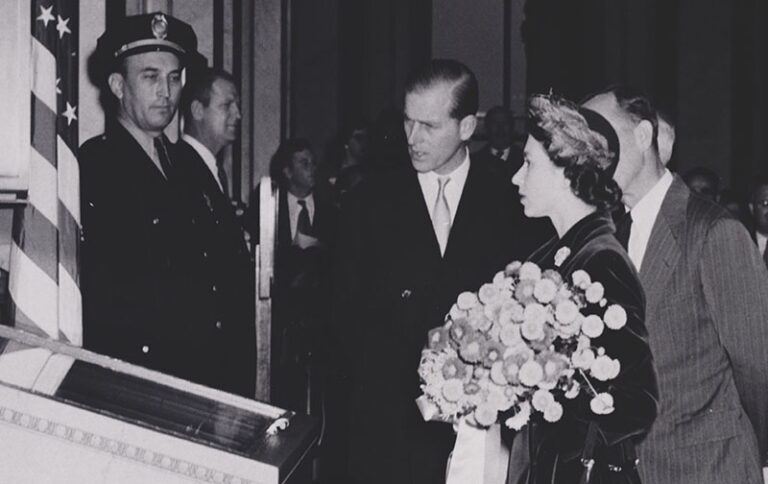September 9, 2022 by John Sayers, Library of Congress
Queen Elizabeth II reigned over the United Kingdom for nearly a third of the United States’ existence, a poignant observation from the national capital of a country that her predecessors once fought to keep as a colonial outpost.
She started out as a princess, became queen and seemed to evolve into the definition of regal restraint and poise. She was the longest reigning monarch in her nation’s history, a woman who kept a stiff upper lip and her head above the tumults of the day, be they the end of the nation’s colonial empire or of family scandals. Her job was to personify the national ideal and she did.
She visited the Library twice and left the staff in awe both times. The lady had presence. The first was in 1951, when she was Princess Elizabeth, and then in 1991, when she was Queen Elizabeth II.
“On May 15 the Library rolled out the red carpet. The occasion was a call from Her Majesty Queen Elizabeth II, as part of a three-day state visit to Washington. She came came with a party of 17, including her husband, Prince Philip, the Duke of Edinburgh.
As hundreds of onlookers craned their necks, stood on their toes, binoculars at the ready, for even a peek at her majesty from behind a blockade across the street, the official party was greeted at about 1 p.m. … A long, black limousine with the queen arrived at the southwest front of the Jefferson Building driveway.”
The royal party was greeted by then-Librarian of Congress James H. Billington and led up a red carpet to be received by a large delegation of Senators and Congressmen. A high school band played, and a reception included film and entertainment personalities including actors Jane Fonda (with her then-husband Ted Turner), Ben Kingsley and Angela Lansbury, who, with director Martin Scorsese, were in attendance as part of a British film festival co-sponsored by the Library and BAFTA, the British Academy of Film & Television Arts.
In 1951, she was still Princess Elizabeth and Harry Truman was still president.
Here’s how the Library’s Information Bulletin recorded that visit:
“Their Royal Highnesses, Princess Elizabeth and the Duke of Edinburgh, expressed great pleasure that [the Library of Congress] was included in their tour on Friday, and the Princess was deeply impressed with the fact that so many staff members turned out to greet them. Mr. Clapp conducted the 20-minute tour of [the Library], which included viewing the Main Reading Room from the Gallery and exhibits on the second floor.
“In addition to Their Royal Highnesses, the Royal party included the British Ambassador Sir Oliver Franks and Lady Franks, Canadian Ambassador Hume Wrong and Mrs. Wrong, Canadian Secretary of State for External Affairs Lester Pearson and Mrs. Pearson, the Princess’ Lady in Waiting, Their Royal Highnesses’ Equerry, the Secretary of the Royal Household, and Mr. John F. Simmons, chief of protocol in the State Department. Official photographers and press representatives also accompanied the party. LC staff members who were presented to the Royal couple were: Messrs. Buck, Mearns, Andreassen, Adkinson, Wagman, Keitt, Fisher, Gilbert, Krould and Webb.
“Besides viewing the Main Reading Room and the Shrine documents, the visitors saw the memorabilia of the Presidents, the “Milestones of American Achievement” and other regular LC exhibits, and a special display arranged in their honor, which included: A letter of condolence on the death of President Lincoln from Queen Victoria to Mrs. Lincoln; a letter from Thomas Jefferson to James Monroe calling attention to the importance of friendship with Great Britain; a letter in King George V’s handwriting to President Wilson expressing “deep satisfaction” that the two English-speaking nations were working together; and a sketch of the Battle of Trafalgar between Lord Nelson and the combined fleets of France and Spain, with a letter describing the action.
“Both the Princess and the Duke expressed keen interest in the exhibits. They had learned the Gettysburg Address and were pleased to see the original; the Princess was particularly interested in Queen Victoria’s letter, asking how LC happened to have it; the Duke studied the sketch of the Battle of Trafalgar; and both of them asked questions about the Shrine documents and the new preservation processes.”
It was, of course, another time. There’s a new King now, Charles III, and a new era. Carry on.


